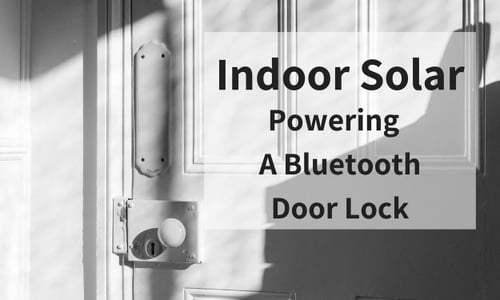Posted on 09/20/2018 at 12:00 by
Samuel Jones

What comes to mind when you think about solar power?
Large solar farms that collect energy measured by the kilowatt?
Perhaps Elon Musk and his lofty solar shingles project?
While the aforementioned examples are indeed solar power at work, PowerFilm is unconventional to the core and we continually push the boundaries of how and where solar technology can be used.
Solar isn’t just for rooftops with direct sunlight anymore, many electronics can be powered using solar in shady and even indoor conditions.
To demonstrate this we created a demo video with the Solar Development Kit powering three different electronic devices; a Nordic Bluetooth Beacon, a Pulsing Fan, and a Bluetooth Door Lock, all in an indoor setting.
For this post, I will focus on the solar powered MiLocks Bluetooth Door Lock and the capabilities it demonstrates.
The most challenging aspect of this example was providing enough power to run the DC motor which drives the locking mechanism. This specific motor requires over 0.5A between 3-6V.
To power it with the Solar Development Kit we had to change the storage element, adjust the charging scheme, and add more solar.
The stock Li-Ion battery and regulated output aren’t able to provide enough current. Instead, we used two series-connected supercapacitors which combined to be 10F 5.4V, which powered the door lock directly.
The supercaps can also be charged to 5.4V which better utilizes the operating range of the motor.
Four LL200-3-37 Indoor Solar Panels were combined in parallel which gave us the additional power needed.
As an additional feature, an LED was placed across the unused output and configured to turn on when the capacitor reached 80% full.
MiLocks provides an interactive mobile app which is able to connect to and toggle the door lock. The door lock can also be toggled using the button keypad.
When fully charged, the supercapacitors are able to cycle the lock 15-20 times. In a shaded outdoor environment (25,000 Lux) the system can charge in as little as 15 minutes.
In a bright indoor environment (1000 lux) the system will fully charge in about 6 hours, or support 2 cycles per hour.
While slightly modified, this Bluetooth door lock can be powered using the same indoor solar material available in the Solar Development Kit.
Applications for light energy harvesting are endless.
Indoors and outdoors, our automated world is full of small motors and actuators that can use light harvesting as a power source.
Smart devices need smart power sources and the Solar Development Kit is a fantastic place to start.
Do you have a device that could be powered using indoor solar?
Contact us or leave a comment below and we can work with you to find the best solution possible.